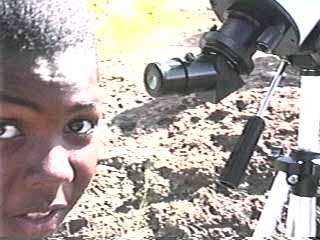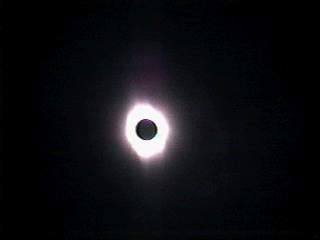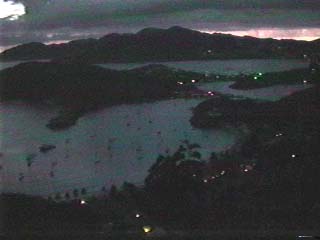Feb 26, 1998 Eclipse at Shirley Heights Antigua
As we were stepping off the plane onto the runway in Antigua, one of
the flight attendants asked me, "Do I look at the eclipse with regular
shades or like 3D glasses?" We had ordered some extra shades, so
we gave one to her. "Here, these will work."
Soon the pilot and other flight attendants were asking her about them.
The next day we sailed, kayaked and snorkled in the deep bay adjacent
to our hotel. While we were waiting for lunch, we overheard a persistant
salesman pushing his product.
"Eclipse shades for sale, they'll keep you from going
blind!"
The woman on the beach was unimpressed. "How much are they?",she
inquired.
"Only $5.00."
She laughed,"That's alot, I could buy some rum with that."
On Feb 26 at 10:00 a.m., we took a taxi south from our hotel to Shirley
Heights, Antigua. Our taxi bumped over potholes and past spray painted
signs which warned people to use eclipse shades. Astronomers and eye doctors
had appeared on television the night before to explain safe ways of viewing
the eclipse. Antigua did an excellent job of educating its people. The U.S. could learn from them.
We viewed the eclipse from the fort at Shirley Heights. The fort dated
from Antiga's British Colonial days and offered an excellent view of the
boats moored in English Harbor, Nelson's dockyard and Montserrat off in
the distance. People were selling beads, braids, T-shirts, and eclipse
shades. A Steel Drum band was playing as the crowds began to appear.
 Nearly everyone
already had their silvery eclipse shades. We set up our telescope and
binoculars (both equipped with mylar solar filters.) When a few children grew
curious,
I aimed the telescope out to sea where a U.S. navy patrol boat was circling.
Furthur out, a large cruise ship had positioned itself midway between Guataloupe
and Antigua, near the center of the moon's shadow.
Nearly everyone
already had their silvery eclipse shades. We set up our telescope and
binoculars (both equipped with mylar solar filters.) When a few children grew
curious,
I aimed the telescope out to sea where a U.S. navy patrol boat was circling.
Furthur out, a large cruise ship had positioned itself midway between Guataloupe
and Antigua, near the center of the moon's shadow.
The Shirley Heights pub was selling flying fish burgers and various
other carribean "jerk" dishes. The noon sun was high and hot
as I stood in line for lunch. The circular hole in my lunch ticket projected
an image of the sun onto the shoes of the man in front of me. Soon a small
bite was taken out of the sun. This is about how it would have looked from
my home in Wisconsin. But here there was much more to come...
 The moon gradually crept across
the face of the sun. At approximatly 13:45 local time it
swallowed a particularly large sunspot. As the sun narrowed
into a crescent, more people crowded towards the edge of the
cliff to see if they could catch a glimpse of the oncomming
shadow. We had to relocate. The first place we tried was
already occupied by a cactus (obscurred by the deepening shadows. Ouch!)
We finally found a tiny spot astride a rock crevice on the edge of the
hill. It was just big enough for us, but I had to leave the telescope
behind.
The moon gradually crept across
the face of the sun. At approximatly 13:45 local time it
swallowed a particularly large sunspot. As the sun narrowed
into a crescent, more people crowded towards the edge of the
cliff to see if they could catch a glimpse of the oncomming
shadow. We had to relocate. The first place we tried was
already occupied by a cactus (obscurred by the deepening shadows. Ouch!)
We finally found a tiny spot astride a rock crevice on the edge of the
hill. It was just big enough for us, but I had to leave the telescope
behind.

The sun was 49 degrees above the horizon to our southwest. Below
and to the right was the island of Montserrat. Grey clouds of ash and
steam rose from Montserrat's Souffriere Hills volcano. There were a few
false reports of the shadow's advance as clouds darkened the waters in
front of us. Soon there was an obvious darkening of Montserrat. Then
almost without warning, totality arrived to Antigua. The sky was a deep
dark blue, the corona a whispy blue-white and all around us was the
orange-red color of sunset. The smoldering volcano was backlit by the
eerie glow from outside the shadow. The planets mercury, venus and
jupiter shone brightly to either side of the eclipsed sun. It was almost
as though we'd been suddenly transported to an ancient volcanic world and
observed our solar system from the outside.
 Streetlights
came on below, as did the anchor lights of the boats in the harbour. It
was as dark as twilight perhaps 1 hour after sunset. The light reminded
me of the blue glow of a clear cold Wisconsin evening. We were no longer
hot. The combined SPFs of our suntan lotion and the moon was probably over
1 million. I tried to catch a little bit of the eclipse by aiming the videocamera
towards the eclipsed sun and I attempted some 35mm photos on Kodachrome.
Unfortunatly I'd forgotten to switch the camera to manual mode, so the
camera chose a 30 second exposure, almost 1/4 of the eclipse. Less than
3 minutes after totality began, we saw the 2nd
diamond ring. Someone was married just before totality, and
just when the first bright beam of sunlight shone from behind the moon to
create a diamond ring in the sky, I asked Ginnie to marry me.
Streetlights
came on below, as did the anchor lights of the boats in the harbour. It
was as dark as twilight perhaps 1 hour after sunset. The light reminded
me of the blue glow of a clear cold Wisconsin evening. We were no longer
hot. The combined SPFs of our suntan lotion and the moon was probably over
1 million. I tried to catch a little bit of the eclipse by aiming the videocamera
towards the eclipsed sun and I attempted some 35mm photos on Kodachrome.
Unfortunatly I'd forgotten to switch the camera to manual mode, so the
camera chose a 30 second exposure, almost 1/4 of the eclipse. Less than
3 minutes after totality began, we saw the 2nd
diamond ring. Someone was married just before totality, and
just when the first bright beam of sunlight shone from behind the moon to
create a diamond ring in the sky, I asked Ginnie to marry me.
I've displayed a few photos here but there is no way to capture the
experience on film, video or with words. If you appreciate the beauty of
the sky or if you are a romantic and would like to experience another perspective
on our small world, try to find your way into the moon's shadow. The
next two total solar eclipses will be in southern Africa
Charles
Andres has a great photo taken from Johnson
Point, Antigua at almost exactly the same moment as
my Montserrat
photo.
Here's a link to other photos and descriptions on Fred
Espenak's page. (Fantastic!)
Here is a folk tale from the Menominee nation http://www.menominee.com/tales/sun.htm
 Nearly everyone
already had their silvery eclipse shades. We set up our telescope and
binoculars (both equipped with mylar solar filters.) When a few children grew
curious,
I aimed the telescope out to sea where a U.S. navy patrol boat was circling.
Furthur out, a large cruise ship had positioned itself midway between Guataloupe
and Antigua, near the center of the moon's shadow.
Nearly everyone
already had their silvery eclipse shades. We set up our telescope and
binoculars (both equipped with mylar solar filters.) When a few children grew
curious,
I aimed the telescope out to sea where a U.S. navy patrol boat was circling.
Furthur out, a large cruise ship had positioned itself midway between Guataloupe
and Antigua, near the center of the moon's shadow. The moon gradually crept across
the face of the sun. At approximatly 13:45 local time it
swallowed a particularly large sunspot. As the sun narrowed
into a crescent, more people crowded towards the edge of the
cliff to see if they could catch a glimpse of the oncomming
shadow. We had to relocate. The first place we tried was
already occupied by a cactus (obscurred by the deepening shadows. Ouch!)
We finally found a tiny spot astride a rock crevice on the edge of the
hill. It was just big enough for us, but I had to leave the telescope
behind.
The moon gradually crept across
the face of the sun. At approximatly 13:45 local time it
swallowed a particularly large sunspot. As the sun narrowed
into a crescent, more people crowded towards the edge of the
cliff to see if they could catch a glimpse of the oncomming
shadow. We had to relocate. The first place we tried was
already occupied by a cactus (obscurred by the deepening shadows. Ouch!)
We finally found a tiny spot astride a rock crevice on the edge of the
hill. It was just big enough for us, but I had to leave the telescope
behind. 
 Streetlights
came on below, as did the anchor lights of the boats in the harbour. It
was as dark as twilight perhaps 1 hour after sunset. The light reminded
me of the blue glow of a clear cold Wisconsin evening. We were no longer
hot. The combined SPFs of our suntan lotion and the moon was probably over
1 million. I tried to catch a little bit of the eclipse by aiming the videocamera
towards the eclipsed sun and I attempted some 35mm photos on Kodachrome.
Unfortunatly I'd forgotten to switch the camera to manual mode, so the
camera chose a 30 second exposure, almost 1/4 of the eclipse. Less than
3 minutes after totality began, we saw the
Streetlights
came on below, as did the anchor lights of the boats in the harbour. It
was as dark as twilight perhaps 1 hour after sunset. The light reminded
me of the blue glow of a clear cold Wisconsin evening. We were no longer
hot. The combined SPFs of our suntan lotion and the moon was probably over
1 million. I tried to catch a little bit of the eclipse by aiming the videocamera
towards the eclipsed sun and I attempted some 35mm photos on Kodachrome.
Unfortunatly I'd forgotten to switch the camera to manual mode, so the
camera chose a 30 second exposure, almost 1/4 of the eclipse. Less than
3 minutes after totality began, we saw the